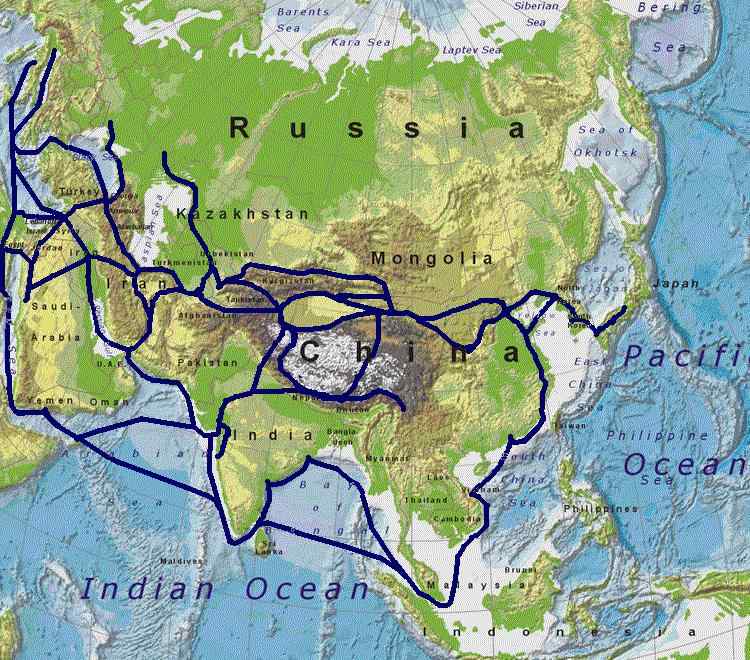The Silk Road: How Ancient Trade Routes Shaped the Modern World
The Enduring Legacy of the Silk Road: Connecting Ancient Civilizations and Modern Global Trade

Introduction

Embark on a fascinating journey through history to explore the Silk Road, an ancient network of trade routes that profoundly shaped civilizations. Far more than just a path for commerce, these vital trade routes fostered unparalleled cultural exchange and global connections between the East and West. This article delves into the remarkable impact and timeless lessons of the Silk Road, from its ancient origins to its modern-day echoes.
The Origins and Expansion of the Silk Road: Ancient Trade Routes Flourish (2nd Century BCE – 15th Century CE)

Originating around the 2nd century BCE, the Silk Road was not a single path but a complex web of ancient trade routes stretching across Asia, linking China to the Mediterranean. For over 1500 years, it facilitated the exchange of goods like silk, spices, precious metals, and textiles. This vast network connected empires and regions, laying the foundation for early globalization and robust East and West connections that defined an era of unprecedented prosperity and interaction.
Beyond Commerce: The Silk Road as a Catalyst for Cultural Exchange and Innovation

While the economic impact of the Silk Road is undeniable, its true legacy extends far beyond mere commodities. These ancient trade routes served as crucial conduits for the movement of ideas, technologies, and artistic traditions. It was a melting pot where diverse cultures met, influenced each other, and spurred advancements, making it a fundamental force in cultural exchange and global intellectual development.
Religious and Philosophical Exchange Across Ancient Trade Routes

The Silk Road played a pivotal role in the transmission of major religions and philosophies across continents. Buddhism, for instance, traveled from India to China via these routes, transforming Asian spiritual landscapes. Similarly, Zoroastrianism, Manichaeism, and later Islam, found new adherents and adapted as they journeyed along the ancient trade networks, profoundly influencing the beliefs and practices of various societies.
Scientific and Technological Transfers: Shaping Global Progress

Beyond spiritual ideas, the Silk Road facilitated significant scientific and technological transfers. Innovations such as papermaking, printing, gunpowder, and the compass moved from China westward, revolutionizing fields from warfare to navigation. In return, the East benefited from advancements in astronomy, medicine, and mathematics from Persia, India, and the Hellenistic world, showcasing the mutual benefits of these global connections.
Cultural and Artistic Fusion: A Tapestry of Global Influences
Art and culture blossomed along the Silk Road, creating a vibrant fusion of styles and traditions. Architectural designs, musical instruments, painting techniques, and textile patterns were exchanged and adapted, leading to unique hybrid art forms. This cultural exchange enriched local aesthetics and left an indelible mark on the artistic heritage of all regions touched by these extraordinary trade routes.
The Dark Side of Connectivity: Disease Transmission on the Silk Road

While the Silk Road brought immense benefits, it also had a devastating downside: the transmission of diseases. Pathogens, carried by merchants, travelers, and their animals, spread rapidly across continents. The most infamous example is the Black Death, which originated in Asia and ravaged Europe in the 14th century, demonstrating how interconnectedness, while beneficial, also carried significant risks for public health across these ancient trade routes.
Decline and Transformation: Shifting Global Trade Routes (15th–20th Century)

By the 15th century, the prominence of the overland Silk Road began to wane. The rise of maritime technology and the Age of Exploration opened new sea routes, offering safer and more efficient ways to transport goods between East and West. This shift in global trade patterns, coupled with political instability in Central Asia, led to a gradual decline in the traditional ancient trade routes, transforming the dynamics of international commerce.
The Modern Revival: China’s Belt and Road Initiative (BRI) (21st Century)

In the 21st century, the spirit of the Silk Road has been revived through China's ambitious Belt and Road Initiative (BRI). This massive infrastructure and investment project aims to enhance global connectivity and foster global trade by developing new land and sea routes connecting Asia with Europe and Africa. The BRI seeks to recreate modern trade networks, echoing the historical significance of its ancient predecessor.
Opportunities and Controversies of the Modern Silk Road Initiative

The Belt and Road Initiative presents both immense opportunities and significant controversies. Proponents highlight its potential to boost economic development, improve infrastructure, and strengthen global connections in participating countries. Critics, however, raise concerns about debt sustainability, environmental impact, and geopolitical implications, underscoring the complex challenges of such a monumental global trade undertaking.
Cultural Revival and Enhanced Global Understanding

Beyond economics and infrastructure, the modern Belt and Road Initiative also aims to foster cultural exchange and understanding. Through educational programs, tourism, and diplomatic efforts, it seeks to build bridges between diverse nations, reminiscent of the ancient Silk Road's role in promoting inter-civilizational dialogue and shared heritage, reinforcing East and West connections in a contemporary context.
Conclusion: The Enduring Wisdom of the Silk Road – A Timeless Lesson in Interconnectedness
The Silk Road, in its ancient and modern forms, stands as a powerful testament to the enduring human desire for connection and exchange. From facilitating early global trade and profound cultural exchange to inspiring today's ambitious infrastructure projects, its legacy underscores the critical importance of interconnectedness. Understanding the history of these ancient trade routes offers invaluable lessons for navigating the complexities of our increasingly globalized world, reminding us that genuine progress often stems from bridging divides and fostering mutual understanding between all peoples.
